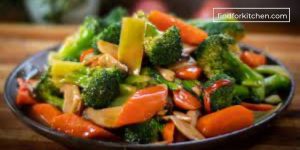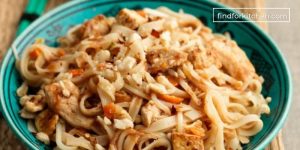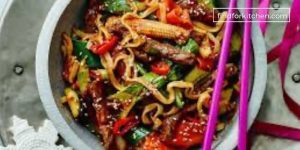Induction stoves have become increasingly popular in recent years, but many people wonder if they can use a wok on an induction stove. The answer is yes, but you need to use the right type of wok – specifically, an induction wok. In this blog post, we’ll compare induction woks and traditional woks, explore the benefits of cooking with an induction wok, offer tips for choosing the best induction wok, and provide recipes for cooking with an induction wok. Additionally, we’ll cover how to clean and maintain your induction wok to ensure it lasts for years to come. Whether you’re a seasoned cook or just getting started, read on to learn why an induction wok may be the perfect addition to your kitchen.
Table of Contents
Can You Use a Wok On An Induction Stove?
When it comes to purchasing a new cooktop, one of the most popular options on the market today is the induction stove. This type of stove operates with a magnetic field, which heats up the cookware rather than the surface of the stove itself. If you’re an avid cook and love experimenting with different types of cuisine, you may be wondering: can you use a wok on an induction stove?
The answer is yes, you can certainly use a wok on an induction stove. In fact, many chefs and home cooks alike prefer using a wok on an induction stove as it allows for precise temperature control and even heating. However, there are a few things to keep in mind when using a wok on an induction stove.
When using a wok on an induction stove, it’s important to choose the right type of wok for your stovetop. Look for a wok that has a flat bottom and is made of a magnetic material. This will ensure that it heats up evenly and efficiently on the induction stove.
Another factor to consider when using a wok on an induction stove is the size. You’ll want to make sure that the diameter of your wok matches the size of the burner on your stove. If your wok is too small or too large, you may run into issues with uneven cooking or heat distribution.
- Yes, you can use a wok on an induction stove
- Choose a wok made of magnetic material with a flat bottom
- Make sure the diameter of the wok matches the size of the burner
Overall, using a wok on an induction stove is a great way to achieve precise temperature control and even heating. Just be sure to choose the right type of wok and keep the size in mind, and you’ll be whipping up delicious stir-fries and noodle dishes in no time!
Comparison Between Induction Wok And Traditional Wok
Woks are an essential part of traditional cooking in many parts of the world, especially in Asian countries. These versatile cooking vessels come in different materials such as stainless steel, cast iron, and carbon steel. Nowadays, with the rapid progress of technology, induction woks have also become quite popular. In this blog post, we will discuss the pros and cons of both traditional woks and induction woks, and help you understand the Comparison Between Induction Wok And Traditional Wok.
The main difference between a traditional wok and an induction wok is the material it’s made of. Traditional woks are typically made of carbon steel or cast iron, while induction woks are made of materials that are magnetic, such as stainless steel or aluminum with magnetic cores. However, there are also carbon steel woks that are specifically designed for use on induction stoves.
Traditional Woks
Traditional woks are incredibly durable and made of carbon steel or cast iron. They are great at holding and distributing heat, while also being pretty easy to maintain. Traditional woks heat evenly and have high heat retention. They are perfect for making stir-fry and deep-frying because of their high sides, which allows the oil to be deep enough to fry foods. Another added advantage of traditional woks is that they come pre-seasoned, which means they are seasoned with oil beforehand and have a non-stick surface. Nevertheless, they do require a bit of effort to keep them in top condition.
Induction Woks
Induction woks are state-of-the-art cooking vessels that come with advanced technology. They are usually made of stainless steel with an aluminum or copper bottom to ensure even heat distribution. Induction woks have a unique feature, where they can quickly heat up and cool down, which is ideal when you need to cook your meals quickly. They also come with temperature control settings, and you can cook your meals on precise temperatures, providing you with more control over your cooking. Induction woks are still relatively new compared to traditional woks, and they do require a different type of range like induction cooktops.
| Traditional Woks | Induction Woks |
|---|---|
| Made of carbon steel or cast iron | Made of stainless steel with an aluminum or copper bottom |
| Can heat evenly and have high heat retention | Can quickly heat up and cool down |
| Durable and easy to maintain | New, require a different type of range like induction cooktops |
| Can provide a non-stick surface | Have precise temperature control settings |
In conclusion, both traditional woks and induction woks offer their pros and cons. They both have unique features that can come in handy when cooking, and it all depends on personal preference. Ultimately, it comes down to the cook’s preference, their cooking style, and the type of stove they have. Induction woks might be more advanced, but traditional woks provide that unique flavor that many home cooks prefer. So don’t be afraid to try out both and see what works best for you.
Benefits Of Cooking With An Induction Wok
Induction cooking has been around for quite some time now, and with its growing popularity, people have started to invest in induction cookware. One such cookware is an induction wok. Cooking with an induction wok has a lot of benefits, and in this blog post, we will shed light on some of the most important ones that will make cooking with an induction wok a worthwhile experience.
Firstly, an induction wok is known for its energy efficiency. Unlike traditional stovetops, induction cooktops heat only the cookware and not the air around it. This ensures that the heat is focused on the wok, thus cooking your food more quickly and efficiently. This, in turn, saves energy and reduces your electricity bill in the long run.
Another advantage of cooking with an induction wok is that it is easy to clean. Induction cookware is made of non-porous materials, which means that your food won’t stick to the wok, making it easier to clean. Additionally, as the heat is focused directly on the wok, any spills or splatters are contained within the wok, making your cleaning process a breeze.
| Traditional Wok | Induction Wok |
|---|---|
| Requires seasoning before use | Does not require seasoning |
| Uneven heating | Even heating |
| Not suitable for all stovetops | Suitable for all induction cooktops |
Cooking with an induction wok also ensures even heating. Traditional woks tend to have hotspots that can burn your food or leave it uncooked. However, with an induction wok, the heat is evenly distributed throughout the wok, ensuring that your food is cooked perfectly.
In conclusion, cooking with an induction wok has a lot of advantages; from its energy efficiency to its even heating and easy cleaning. Investing in an induction wok is a smart choice that will elevate your cooking experience and make your life easier in the long run.
Tips For Choosing The Best Induction Wok
Choosing the best wok for your induction stove can seem like a daunting task. With so many options available in the market, it can be overwhelming to decide which one would be the best fit for your cooking needs. Here are some tips that will help you make an informed decision when selecting an induction wok.
1. Material: The first thing to consider when choosing an induction wok is the material. The most common materials used in making woks are carbon steel, stainless steel, and cast iron. Carbon steel is a popular choice among chefs due to its lightweight and ability to heat up quickly. Cast iron is a great choice if you are looking for a heavy-duty wok that can withstand high temperatures. Stainless steel is another option, but it is not as popular as carbon steel or cast iron.
2. Size: Woks come in various sizes, ranging from 10 to 14 inches. The size you choose will depend on how much food you usually cook at once. If you have a large family or enjoy hosting dinners, a 14-inch wok would be a great choice. If you cook for one or two people, a 10-inch wok would suffice.
| Size (in inches) | Number of People |
|---|---|
| 10 | 1-2 |
| 12 | 2-4 |
| 14 | 4+ |
3. Handles: The handles of the wok are also an important consideration. The two most common types of handles are long and short. A wok with long handles will make it easier to toss and stir-fry food, but it may be challenging to store. Woks with short handles are easier to store, but they may not be as convenient to use while cooking. Choose the handle based on your preference and convenience.
By keeping these tips in mind, you can choose the best induction wok for your cooking needs. Remember, the right wok can make a huge difference in the taste and quality of your dishes. Happy wokking!
How To Clean And Maintain Your Induction Wok
Keeping your induction wok clean and maintaining it is essential to ensure it continues to function correctly and lasts for a long time. It’s also necessary to maintain the flavors of the food you cook. Here are some tips on how to clean and maintain your induction wok.
| Step | Action |
|---|---|
| 1 | After cooking, remove all food and any possible burnt residues left on the wok. |
| 2 | Rinse the wok with water and use a soft sponge or cloth to remove the remaining stains. Do not use abrasive cleaning tools because they can damage the wok’s surface. |
| 3 | Dry the wok thoroughly after washing it. Avoid leaving any moisture on the surface because it may promote rusting. |
| 4 | If you notice any discoloration or burnt residue on the induction wok, mix baking soda and water to create a paste. Apply the paste to the stained area and use a soft sponge to remove the stain. |
| 5 | When storing the wok, it is best to separate it from other items to avoid any damage. You can also place a paper towel inside the wok to prevent moisture from accumulating. |
Don’t forget that some woks need seasoning to help with the cooking process. Follow the manufacturing guide on how to season and re-season the wok to keep it functioning correctly. By following these simple tips, you can ensure that your induction wok remains in great shape and looks as good as new for a long period.
Recipes For Cooking With An Induction Wok
One of the best things about using an induction wok is the ability to cook a wide variety of dishes that are not only delicious but also healthy. Here are some recipes that you can try with your induction wok:
1. Stir-fried vegetables

One of the easiest and healthiest dishes to make is stir-fried vegetables. You can use any vegetable of your choice such as broccoli, carrots, bell peppers, and snap peas. The instructions for stir-fried vegetables is given below:
- Heat some oil in your induction wok and add your vegetables.
- Stir-fry them for about 5-7 minutes until they are cooked but still have a bit of crunch.
- Add some soy sauce and sesame oil for flavor.
2. Pad Thai

This Thai dish is a favorite for many people around the world. In your induction wok, sauté some garlic and shallots in oil. Add some cooked chicken or shrimp and stir-fry for a few minutes. Push the chicken or shrimp to one side of the wok and crack an egg into the wok. Scramble the egg until it’s cooked and then mix it with the chicken or shrimp. Add some cooked rice noodles, bean sprouts, and chopped scallions. Stir-fry everything together for a few more minutes. Season with fish sauce, lime juice, and sugar. Top with crushed peanuts and cilantro.
Ingredients:
- 1 tablespoon oil
- 2 cloves garlic, minced
- 1 shallot, minced
- 1 boneless, skinless chicken breast or 8 large shrimp, peeled and deveined
- 1 egg, beaten
- 4 ounces rice noodles, cooked according to package instructions
- 1/4 cup fish sauce
- 2 tablespoons lime juice
- 2 tablespoons sugar
- 1/4 cup crushed peanuts (optional)
- 1/4 cup cilantro leaves (optional)
Instructions:
- Heat oil in induction wok
- Add garlic to oil and sauté for 30 seconds
- Add shallots to wok and sauté for 30 seconds
- Add chicken or shrimp to wok and stir-fry for 3-5 minutes until cooked
- Push chicken or shrimp to one side of the wok and pour in egg. Scramble egg until cooked, and then mix it with chicken or shrimp.
- Add cooked rice noodles, bean sprouts, and chopped scallions to wok. Stir-fry everything together for 1-2 minutes.
- Season with fish sauce, lime juice, and sugar.
- If desired, top with crushed peanuts and cilantro.
3. Korean-style stir-fried beef

This dish lets you taste different feelings at the same time, this beef is savory, sweet, and spicy all at once. The instructions for Koren-style stir-fried beef is listed below:
- Thinly slice some beef and marinate it in a mixture of soy sauce, sugar, sesame oil, minced garlic, and minced ginger.
- Heat some oil in your induction wok and stir-fry the beef until it’s almost cooked.
- Add some sliced onions, mushrooms, and bell peppers.
- Stir-fry for a few more minutes until the vegetables are cooked but still have a bit of crunch.
- Season with gochujang or Korean chili paste, honey, and sesame seeds.
With your induction wok, the possibilities are endless. These recipes are just a starting point to get your creative cooking juices flowing. Have fun experimenting and enjoy your delicious and healthy meals!
Induction Wok Questions & Answers
Traditional woks are typically made of materials like carbon steel, cast iron, or aluminum. Induction stoves require a magnetic material for heating, so traditional woks made of these materials will not work on an induction stove unless they have a magnetic base.
Induction woks are specially designed with a flat bottom and a magnetic base to work with induction stoves. Traditional woks have a rounded bottom and are made of materials that may not be compatible with induction heating.
Cooking with an induction wok has many benefits, including faster and more even heating, precise temperature control, and energy efficiency. Induction cooking also eliminates the need for an open flame, making it safer and more environmentally friendly.
When choosing an induction wok, consider the material, size, and shape of the wok, as well as its compatibility with your induction stove. Look for woks with a magnetic base, sturdy handles, and a non-stick surface for easy cleaning.
To clean and maintain your induction wok, wash it with warm, soapy water and a soft sponge after each use. Avoid using abrasive cleaners or metal utensils that can scratch the non-stick surface. Make sure to dry the wok thoroughly and store it in a cool, dry place.
Induction woks are great for stir-fries, noodle dishes, and other Asian-inspired recipes. Try making a simple vegetable stir-fry with your favorite veggies and a savory sauce, or experiment with different types of noodle dishes like pad thai or lo mein.
While induction woks are designed primarily for stir-frying and other Asian-inspired recipes, they can also be used for other types of cooking like sautéing, searing, and even deep-frying. Just be sure to follow the manufacturer’s instructions and use the appropriate temperature settings.

Hi, I’m Jen from New Mexico. I have been working from home as a graphic designer for a long time. While working at home, I realized that I enjoy spending time in the kitchen. The kitchen is my biggest hobby. I set up this site to relay the products and experiences I’ve tried. I review many kitchen equipment and share them with you!






